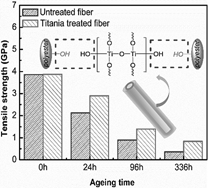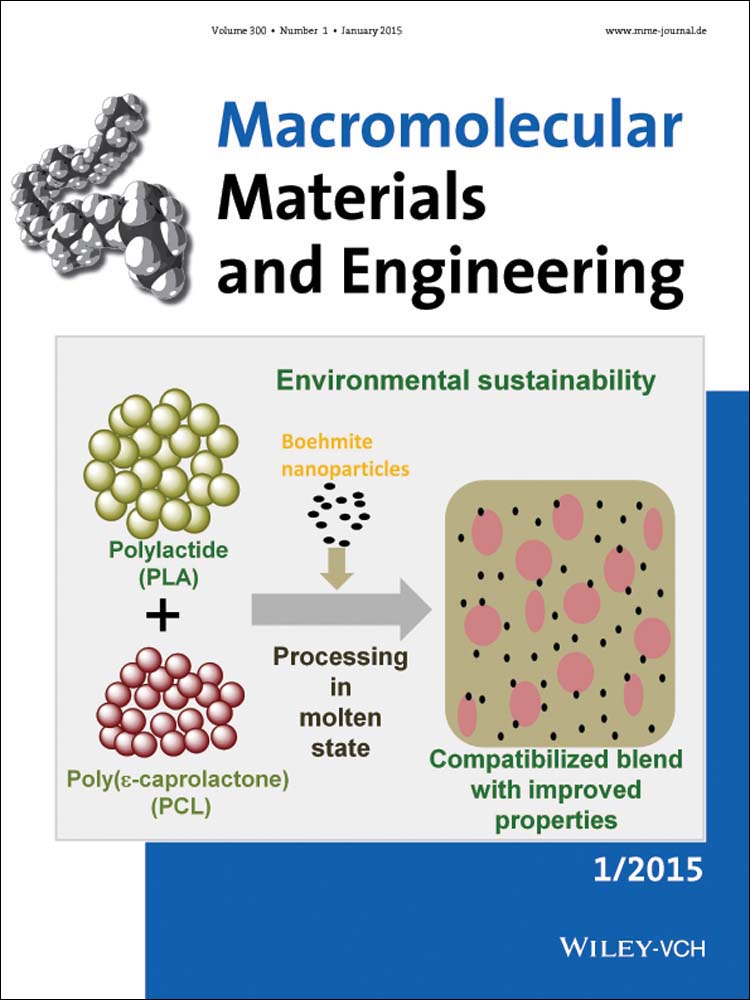Hyperbranched Polyester-Stabilized Nanotitania-Coated Vectran Fibers with Improved UV-Blocking Performance
Correction(s) for this article
-
Hyperbranched Polyester-Stabilized Nanotitania-Coated Vectran Fibers with Improved UV-Blocking Performance
- Volume 300Issue 3Macromolecular Materials and Engineering
- pages: 377-377
- First Published online: March 9, 2015
Yuxi Liu
School of Material Science and Chemical Engineering, Chuzhou University, Chuzhou, 239000 China
Search for more papers by this authorCorresponding Author
Yuyan Liu
School of Material Science and Chemical Engineering, Chuzhou University, Chuzhou, 239000 China
Search for more papers by this authorChunhua Zhang
School of Material Science and Chemical Engineering, Chuzhou University, Chuzhou, 239000 China
Search for more papers by this authorHuifeng Tan
National Key Laboratory of Science and Technology on Advanced Composites in Special Environments, Harbin Institute of Technology, Harbin, 150080 China
Search for more papers by this authorXingru Yan
Integrated Composites Lab, Dan F. Smith Department of Chemical Engineering, Lamar University, Beaumont, TX, 77710 USA
Search for more papers by this authorHuige Wei
Integrated Composites Lab, Dan F. Smith Department of Chemical Engineering, Lamar University, Beaumont, TX, 77710 USA
Search for more papers by this authorCorresponding Author
Zhanhu Guo
Integrated Composites Lab, Dan F. Smith Department of Chemical Engineering, Lamar University, Beaumont, TX, 77710 USA
Search for more papers by this authorYuxi Liu
School of Material Science and Chemical Engineering, Chuzhou University, Chuzhou, 239000 China
Search for more papers by this authorCorresponding Author
Yuyan Liu
School of Material Science and Chemical Engineering, Chuzhou University, Chuzhou, 239000 China
Search for more papers by this authorChunhua Zhang
School of Material Science and Chemical Engineering, Chuzhou University, Chuzhou, 239000 China
Search for more papers by this authorHuifeng Tan
National Key Laboratory of Science and Technology on Advanced Composites in Special Environments, Harbin Institute of Technology, Harbin, 150080 China
Search for more papers by this authorXingru Yan
Integrated Composites Lab, Dan F. Smith Department of Chemical Engineering, Lamar University, Beaumont, TX, 77710 USA
Search for more papers by this authorHuige Wei
Integrated Composites Lab, Dan F. Smith Department of Chemical Engineering, Lamar University, Beaumont, TX, 77710 USA
Search for more papers by this authorCorresponding Author
Zhanhu Guo
Integrated Composites Lab, Dan F. Smith Department of Chemical Engineering, Lamar University, Beaumont, TX, 77710 USA
Search for more papers by this authorAbstract
An OH terminated hyperbranched polyester is used to stabilize TiO2 nanomaterials (10 nm) in situ synthesized via a sol–gel method with butyltitanate as precursor. X-ray diffraction (XRD) analyses and thermogravimetric (TGA) analyses illustrate the interactions of the hyperbranched polyester with the TiO2 nanoparticles. The stabilized TiO2 nanocomposites are used in the finishing process of Vectran and a continuous uniform TiO2 coating on the Vectran fiber surface is achieved. The TiO2-treated Vectran filaments exhibit an increased tensile strength compared to the untreated Vectran systems upon exposure to Xenon lamp UV radiation. The coating leads to improved UV-blocking performance.
References
- 1 C. Saw, G. Collins, J. Menczel, M. Jaffe, J. Therm. Anal. Calorim. 2008, 93, 175.
- 2 W. Kang, Y. Suh, K. Woo, I. Lee, Compos. Struct. 2006, 75, 151.
- 3 Y. Liu, Y. Liu, H. Tan, C. Wang, H. Wei, Z. Guo, Polym. Degrad. Stab. 2013, 98, 1744.
- 4 X. Su, Q. Wu, X. Zhan, J. Wu, S. Wei, Z. Guo, J. Mater. Sci. 2012, 47, 2519.
- 5 S. Wei, P. Mavinakuli, Q. Wang, D. Chen, R. Asapu, Y. Mao, N. Haldolaarachchige, D. P. Young, Z. Guo, J. Electrochem. Soc. 2011, 158, K205.
- 6 R. Asapu, V. M. Palla, B. Wang, Z. Guo, R. Sadu, D. H. Chen, J. Photochem. Photobiol. A 2011, 225, 81.
- 7 L. Shao, Y. Yao, S. Quan, H. Wei, R. Wang, Z. Guo, Mater. Lett. 2014, 114, 111.
- 8 L. Shao, S. Quan, Y. Liu, Z. Guo, Z. Wang, Mater. Lett. 2013, 107, 307.
- 9 G. Liu, Z. Chen, C. Dong, Y. Zhao, F. Li, G. Q. Lu, H. M. Cheng, J. Phys. Chem. B 2006, 110, 20823.
- 10 N. Abidi, L. Cabrales, E. Hequet, ACS Appl. Mater. Interfaces 2009, 1, 2141.
- 11 B. Fei, Z. Deng, J. H. Xin, Y. Zhang, G. Pang, Nanotechnology 2006, 17, 1927.
- 12 H. Liang, A. Ueno, K. Shinohara, Chem. Eng. Res. Des. 2000, 78, 49.
- 13 B. Ding, J. Kim, E. Kimura, S. Shiratori, Nanotechnology 2004, 15, 913.
- 14 A. Pottier, C. Chanéac, E. Tronc, L. Mazerolles, J. P. Jolivet, J. Mater. Chem. 2001, 11, 1116.
- 15 C. Y. Hong, Y. Z. You, D. Wu, Y. Liu, C. Y. Pan, Macromolecules 2005, 38, 2606.
- 16 Y. Xu, C. Gao, H. Kong, D. Yan, Y. Z. Jin, P. C. Watts, Macromolecules 2004, 37, 8846.
- 17 M. Zhao, L. Sun, R. M. Crooks, J. Am. Chem. Soc. 1998, 120, 4877.
- 18 N. Pérignon, A. F. Mingotaud, J. D. Marty, I. Rico Lattes, C. Mingotaud, Chem. Mater. 2004, 16, 4856.
- 19 C. Bao, M. Jin, R. Lu, T. Zhang, Y. Zhao, Mater. Chem. Phys. 2003, 82, 812.
- 20 S. Wei, Y. Zhu, Y. Zhang, J. Xu, React. Funct. Polym. 2006, 66, 1272.
- 21 J. A. Khan, R. K. Kainthan, M. Ganguli, J. N. Kizhakkedathu, Y. Singh, S. Maiti, Biomacromolecules 2006, 7, 1386.
- 22 D. Zhang, L. Chen, D. Fang, G. W. Toh, X. Yue, Y. Chen, H. Lin, Text. Res. J. 2013, 83, 1625.
- 23 H. Gao, D. Yorifuji, J. Wakita, Z. H. Jiang, S. Ando, Polymer 2010, 51, 3173.
- 24 W. A. Daoud, J. H. Xin, J. Sol–Gel Sci. Technol. 2004, 29, 25.
- 25 T. Yuranova, R. Mosteo, J. Bandara, D. Laub, J. Kiwi, J. Mol. Catal. A: Chem. 2006, 244, 160.
- 26 Y. Ku, C. M. Ma, Y. S. Shen, Appl. Catal., B. 2001, 34, 181.
- 27 B. Samuneva, V. Kozhukharov, C. Trapalis, R. Kranold, J. Mater. Sci. 1993, 28, 2353.
- 28 Y. Zhu, L. Zhang, C. Gao, L. Cao, J. Mater. Sci. 2000, 35, 4049.
- 29 J. Zhu, J. Yang, Z. F. Bian, J. Ren, Y. M. Liu, Y. Cao, H. X. Li, H. Y. He, K. N. Fan, Appl. Catal., B. 2007, 76, 82.
- 30 W. A. Daoud, J. H. Xin, J. Am. Ceram. Soc. 2004, 87, 953.
- 31 W. A. Daoud, J. H. Xin, G. K. H. Pang, J. Am. Ceram. Soc. 2005, 88, 443.




